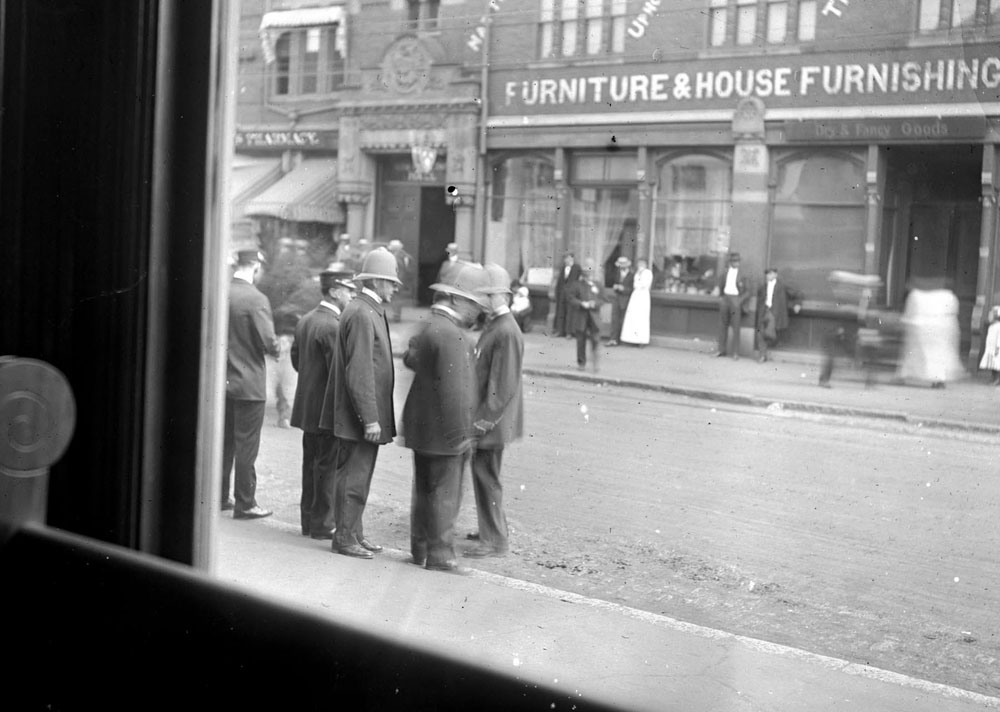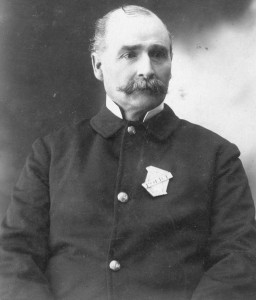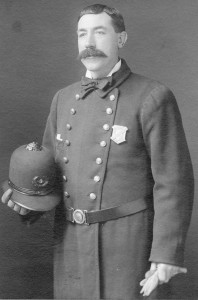True Tales from Canton’s Past: Police Log
By George T. Comeau
Canton’s finest as seen through the window of a downtown Canton shop on Labor Day 1915 (Courtesy of the Canton Historical Society)
Each week one of the most read sections of the Canton Citizen is the Police Log. The small weekly entries detail the petty crimes, break-ins, and traffic accidents across what is generally deemed a very safe community. There is a certain interest in checking in on the crime logs even to become more aware that Canton is no longer the town where we can simply leave our back doors open when running to the grocery store.
Historically speaking, there has always been a “police” presence in Canton. In the early days a constable was appointed by the selectmen to keep the peace. Somewhere long forgotten in the Canton Corner Cemetery is the grave of “Old Lieutenant Puffer,” the constable of Ponkapoag. James Puffer, one of the earliest settlers of this area, received a deed in 1691 of 120 acres northeast of the Milton line from his father. Born in 1665, at age 10 he likely witnessed the massacre of his mother and eldest brother at the hands of the Nipmuck Indians in Mendon. Puffer was appointed constable in 1705. Known as an honorable man, Puffer kept the peace for many years.
There were several constables appointed throughout the 1700s — upstanding citizens like Peter Lyon, Phillip Liscomb, Samuel Hartwell, Shubael Wentworth, and Isaac Fenno. The kinds of crimes that constables handled ranged from petty thefts to drunk and disorderly behavior. One of the more curious customs was the “warning out” of undesirables.
“Warning out” began in 1692 when the General Court passed an act that basically stated that anyone residing in a town for more than three months without being warned out would thereby become an inhabitant of that town for legal purposes. There were exceptions of pursuing an education or medical attention, but warning out became commonplace in order to maintain community standards. Strangers were warned out so that poor people would not become the responsibility of the town.
It was the duty of all heads of households to inform the selectmen of the name, age, occupation, and previous residence of any newcomer. A particularly wonderful letter can be found in an ancient book of Stoughton records. The handwritten note of Timothy Jones, dated September 26, 1734, reads: “Gentlemen, These are to inform you that I have taken one James Phillips into my house a shoemaker by trade, a good workman, he says he has several hundred acres of land in Connecticut, a cup of good liquor stands a very narrow chance when it lies in his way, yet quickly gets the mastery of him when they come to close engagement.” So much for a good reference for Mr. Phillips.
At the sign of any danger a warrant would be issued and the constables would direct the parties out of the town. In 1759, Scipio Lock and his wife, along with two free black men, came to stay at the house of Benjamin Everenden at Pigeon Swamp. A warrant was placed with Constable Isaac Fenno Jr. to warn these parties out of Stoughton. The warrant was served, and yet it seemed that Scipio Lock was slow to leave. An article soon appeared in the town warrant “to see if the town will maintain a Negro man, Scipio Lock, or try to get rid of him by standing a lawsuit.”
Constables continued to be appointed by the selectmen of Stoughton throughout the 1700s. In 1797, as Canton became established, one of the first activities of the newly created town was to choose town officers. Joseph Bemis was appointed Canton’s first treasurer and constable.
For 78 years constables would be appointed, and by the late 1800s the town had between two and four constables who were paid roughly $12 a year plus compensation for serving warrants and issuing licenses. In 1875 the Canton Police Department was formed. Records show that four police officers made up our first force. D. McPherson was paid $316, and his three assistants were each paid various smaller amounts. The first year’s budget went for such sundry items as cleaning the lock-up, mattresses, coal, and materials for the new gratings in the lock-up. Incidentally, the first lock-up is now a private house on Bolivar Street.
The driving force behind the creation of the Canton Police Department in 1875 was not crime per se, but rather the growing intolerance of liquor and evil that these spirits caused. Liquor has always held a special historical significance in Canton. There are so many entries about public drunkenness in the archival records that one wonders why we never wound up a “dry town” much like our neighbor Sharon.
There are spectacular stories in the local papers about raids on moonshine stills deep in the woods. A front-page news item in 1911 reported that “officers raided the premises of some Italians on Maple Street Sunday and secured 62 bottles and 2 kegs of beer.”
In 1896, John Flood was hired as an officer and was paid $27.50 for his services. This young officer would become the longest serving chief of the department. In his early days, however, he was relegated to night duty and alongside Officer John Plunkett would patrol the town center ensuring law and order. Plunkett became the first chief of police in 1900. It is fair to say that Chief Plunkett established the modern police, running the force for 11 years.
By the time that Flood became chief in 1913, a new breed of policeman was in place. The issues became more complex, whether it be maintaining order in the age of the automobile, or dealing with the tremendous influx of new immigrants to the town. Civil service rules enacted at Annual Town Meeting meant that officers were guaranteed one day off in 15 along with two weeks vacation. The Board of Selectmen, writing Chief Flood, told him “it being understood of course that this is within your discretion.”
As Prohibition was in full swing, the Canton Police Department enforced the temperance rules and raids became commonplace occurrences. Interestingly, in 1921, the Massachusetts Department of Public Safety purchased a Ford truck to transport forfeited liquor to the State House. A letter to Chief Flood details the shipping arrangements.
A letter from the Board of Selectmen to Flood in June 1923 alerts him to the fact that the “residents of Neponset Street claim that some of the makers of ‘hooch’ are doing business in the woods near the Rogers Estate on Neponset Street.” Another complaint comes from “a colored lady” living next door to Charlie Bryant on Dedham Street: “She has been disturbed by the parties going on at Charles Bryant’s house and believes there is considerable bootlegging going on.” Liquor seizures, DUI’s, public drunkenness, liquor nuisances, and the sale of moonshine took up a tremendous amount of the department’s time and energy.
And much like today, traffic was a major concern of the early police department. Dozens of complaints are logged that describe parking violations, joyriding, and all sorts of vehicular mayhem. By 1923, the selectmen had advised the police department that “the parking of cars through the center of town could be better accomplished if all cars were parked at an angle of 45 degrees with the curb.”
Yes, progress had come to Canton when orders were issued to the police force that after several complaints detailing “considerable disturbance, noise, foul talk, etc. which has prevailed along Washington Street, it was voted that all stores and restaurants would cease doing business at eleven o’clock in the evening.” The police had to carry this order out — especially at Brown’s Hotel and John Joyce’s Restaurant.
There is a wonderful letter in the files of the Canton Historical Society from J. E. Hoover, the acting director of the Federal Bureau of Investigation, establishing the bureau’s Identification Division. The letter, dated June 25, 1924, lays the groundwork for the federal fingerprinting system, and Canton joined the groundbreaking development in forensic science.
Youth problems also occupied the police department’s time. Parents complained that the local officers were not enforcing the curfew law by not sending children home. The aggrieved parents complained to the Board of Selectmen, who in turn asked the police to step up their observance of curfew rules. The advent of the automobile meant that “parking parties” would hold forth and petting would ensue along the darkest corners of the town. To deal with complaints, especially on Elm, Green and Pecunit streets, police officers were sent on patrols Saturday and Sunday nights, the heaviest petting nights — pun intended.
Even the most mundane complaints were handled on a daily basis, evidenced by the fact that bicycle riding on sidewalks needed to be dealt with by the police department, and they were charged with printing and posting warnings. It was also noted that permission was given by the selectmen to Paul McCarthy to do servile work on the Lord’s Day on May 29, 1927. The police department was to allow him to install memorial flags on the sidewalks around town in observance of Memorial Day.
Not much has changed in our small town. The police department handles all sorts of issues, both large and small. And from our earliest history of the constables, all the way to our modern force today, the mission is the same — to protect and serve the people of Canton.
Short URL: https://www.thecantoncitizen.com/?p=13211












